The Effects of a Combination of New Zealand Green-Lipped Mussel Extract and Marine Lipids on the Improvement of QOL and Pain caused by Lifestyle-Related Diseases

Introduction
The differences in time between London and Tokyo is 9 hours,135 degrees of longitude. You can go from Tokyo to London by bowing 747 in about 12 hours. When you get there you will be tired you will not sleep properly, you will not feel like eating because the digestion system is not good. These are side effects. You can also go to London by ship and by train. It maybe takes 6 days. When you get there, you don’t feel tired, you sleep ok, your digestion system is ok, no side effects. Why? Because in the first case you went too quickly, in the second case you went slowly and quietly.
Now you think I’m at the wrong conference, I should be speaking at a travel conference. That not the case, I’m relating this to the treatment of diseases. If you treat diseases slowly and steadily, not too strong then you don’t get the same side effect as if you treat them with very strong hard hitting drugs. In my conversation today, I want to introduce the principles behind marine derived products, products from the sea. These are marine lipids and extracts from shell fish, from sponges and from other marine animals. I’ll will talk about two of them.
Angiogenesis
1. What is Angiogenesis
Angiogenesis is involved in many natural processes. Like the healing of wounds, menstruation, pregnancy and normally it’s controlled. It’s controlled by promoters and inhibitors, cytokines, growth factors. When these things get out of balance which happens with the development of a tumor. Then we get excessive blood vessel production, metastasis and we have the problem.
Tumors must have blood vessels if they are going to grow beyond about 2mm in diameter. They also need blood vessels so that they can get rid of the waste products, the metabolic products. Otherwise they kill themselves. We know blood vessels, know tumor development. But they are able to express growth factors, cytokines. That will cause these blood vessels to develop and then result is that we have a tumor with its own supply and it can grow and it can metastasis.
The blood vessel is expressing Fibroblast Growth Factor and Vascular Endothelial Growth Factor, Transforming Growth Factor-B2, these are just three. They are into the blood vessel and meeting with receptors. If we can prevent this happening either by blocking the receptors or by preventing the tumor expressing them, then we have a mechanism to inhibit the progress of the disease.
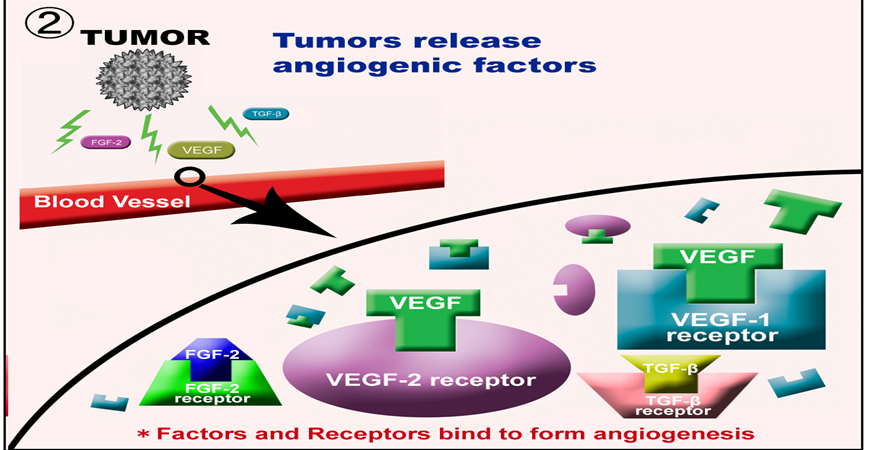
2. Macolipin
Macolipin is a marine lipid (marine lipid) with unique properties extracted from fish meat. Many of its properties are derived from long-chain fatty acids. Various cytokines such as transforming growth factor-β (TGF-β), fibroblast growth factor (FGF), interleukin-1β (IL-1β), and vascular endothelial growth factor (VEGF) are involved in tumor growth and metastasis. The effects of Macolipin on these four factors were studied at the University of Otago. As a result, it was revealed that the pro-angiogenic effects of TGF-β, FGF-2, and VEGF were completely inhibited by Macolipin. On the other hand, it is also known that Macolipin enhances the anti-angiogenic effect of IL-1β.
Inflammation
1. What is inflammation
Inflammation is involved in many diseases, including cancer and arthritis. Therefore, in the treatment of various diseases, it is very important to inhibit inflammation without causing the side effects associated with steroids and NSAIDs. In fact, some tumors that occur in the colon, liver, and lungs develop at sites of inflammation. In this case, it is chronic rather than acute inflammation that affects tumor growth, so inhibiting the inflammatory process of chronic inflammation is important.
2. Apoptosis
When apoptosis is functioning normal, the macrophage comes and eats the neutrophil cells and the macrophage then expresses transforming growth factor β. You may think this is not too good because we really don’t want to TGF-β but when we come to the balancing, TGF-β is anti-inflammatory.
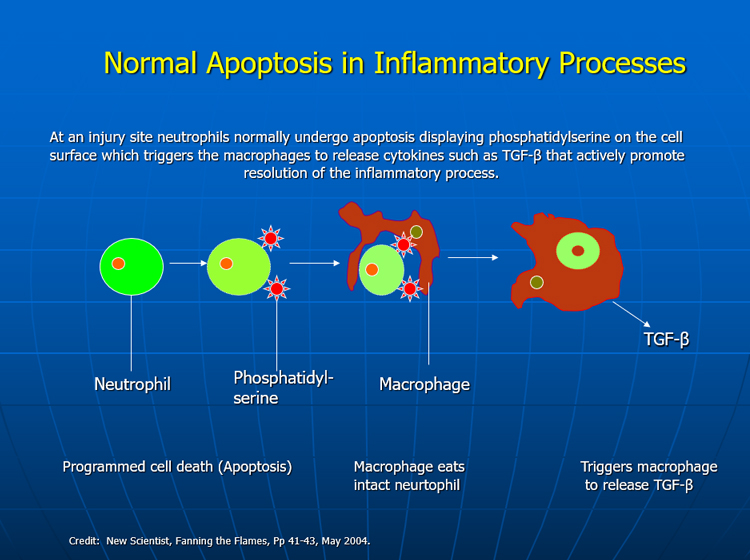
when the situation is not normal and the cells die by necrosis, now the neutrophil dies by necrosis and breaks down like this. The macrophage eats the cell and it expresses TNF-α. I think everybody here is aware of the fact that we really don’t like to have TNF-α present in large quantities. But TNF-α is still a normal part of our body function.
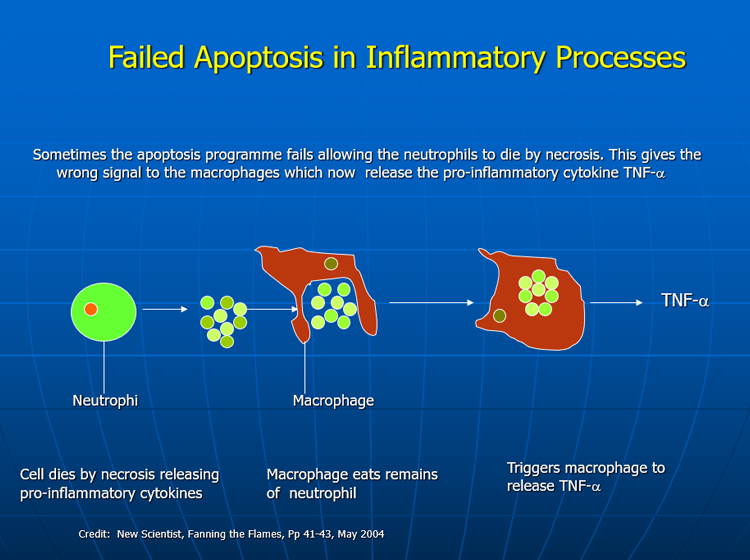
GLME
1. What is GLME
GLME (Green-Lipped Mussel Extract) is an extract of green-lipped mussels that live in New Zealand. Green lipped mussels are very similar to the mussels in Japan but they are a unique species that differs from mussels, and they are also different from the Green Mussels that live in the Philippines and South Africa.
GLME has been shown to have anti-inflammatory, chondroprotective, and gastroprotective properties and has been used for many years in arthrosis and arthritis. GLME is a natural supplement with many functions and has the characteristic of acting from various angles against diseases. More importantly, the effects of GLME are low to moderate. This is the same as going to London by ship or train. In other words, GLME does not have the serious side effects seen with steroids and NSAIDs used to treat arthritis and arthritis. Of course, there is nothing in the world that does not have side effects, so it is not a good idea to say, “Because it is a natural ingredient, it has no side effects.” GLME can also cause indigestion if you don’t follow the instructions to “take it with food”. However, it is true that there are no serious side effects.
2. Anti-inflammatory effects of GLME
Because GLME inhibits inflammatory reactions through various mechanisms, and also has fibrinolytic, anti-oxidant, and anti-platelet activities, it is effective to avoid thrombosis and blood clots. NSAIDs are used for similar purposes, but they also cause severe gastrointestinal problem. In addition to these effects, GLME also has gastroprotective properties.
1) Neutrophil migration
Normally neutrophils are flowing through the blood vessels and at any one time about 50% of them are moving and about 50% are attached to the endothelia wall by addition molecules. When you get an inflammatory stimulates the situation changes, and more of the neutrophils attach to the cell walls. At the same time the integrity of the blood vessel walls deteriorates and the neutrophils are able to escape. And so this causes fluid leakage and escape of the neutrophils to the site of inflammation which causes the swelling, the edema, the pain and the heat. So if you can inhibit this process, then it’s a good thing.
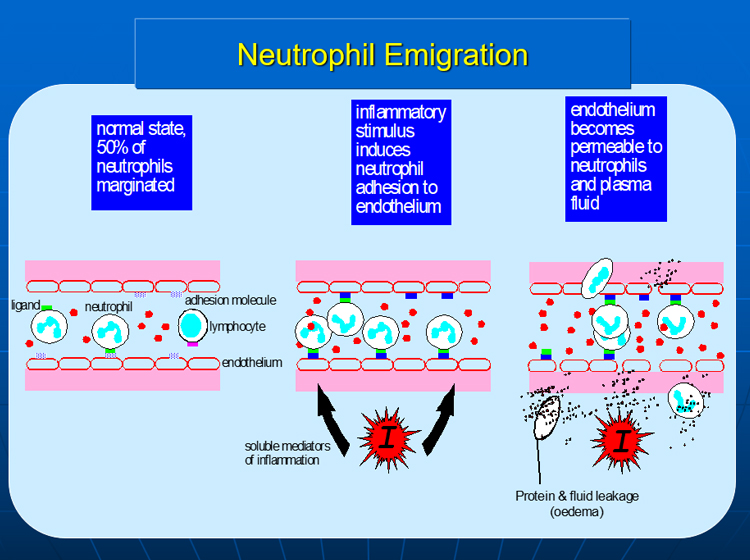
2) Effect of GLME on neutrophil migration
This work is all done at the University of Auckland in New Zealand. And this is showing that the GLME inhibited neutrophil accumulation and also inhibited the amount of inflammatory fluid. This experiment is done by putting small sponges under the skin of the rat. And the sponges are weighed before placing there. Then they are weighed after being taken out at the end of the experiment. You can tell how much fluid and the neutrophil component by this experiment so it was very useful and proves that GLME inhibits neutrophil migration.
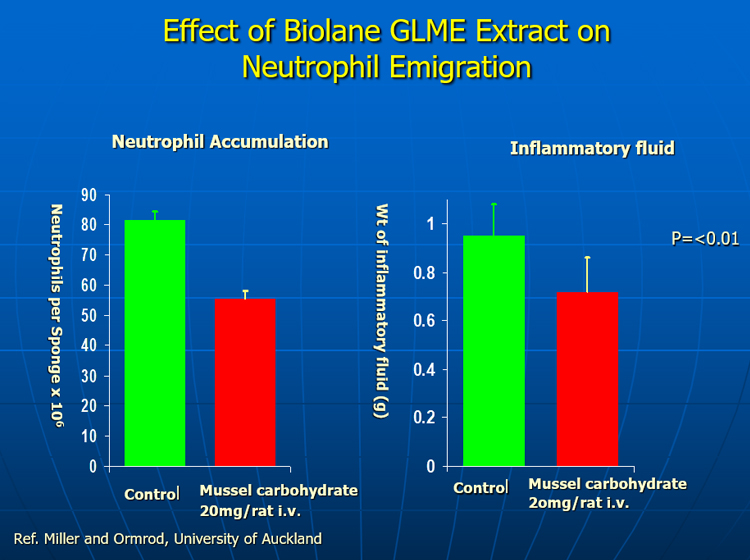
You might worry that if you are inhibiting T-lymphocyte function which is also a thing that GLME does and your inhibiting neutrophil migration, perhaps you are compromising your immune systems. But you are not, you have to inhibit 90% of neutrophil function before immunity is compromised. So you are not inhibiting your immune system by this method.
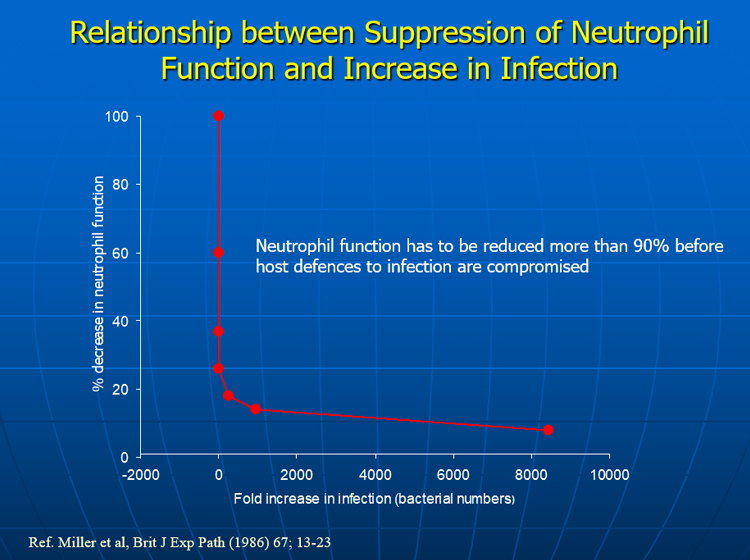
3) Inhibitory effect on other activities of GLME
The University of Queensland and the Southern Cross University in Australia did some very interesting studies on GLME. The reason they are so interesting is that we used to test activity of products by using a solvent, taking out the active component, and testing the active component either cellular level or in an animal model. And if you are really honest, you can’t say that the test relates to exactly what will happen if you eat the product or take it orally. It was the closest we could get.
This work has been done by using a digestive process, two digestions. The first one was pepsin and hydrochloric acid. Then another digestion using pancreatic enzymes. That final product was the one that was tested. That is the closest you can get invitro to what will happen if you the take product orally. These tests are very representative.
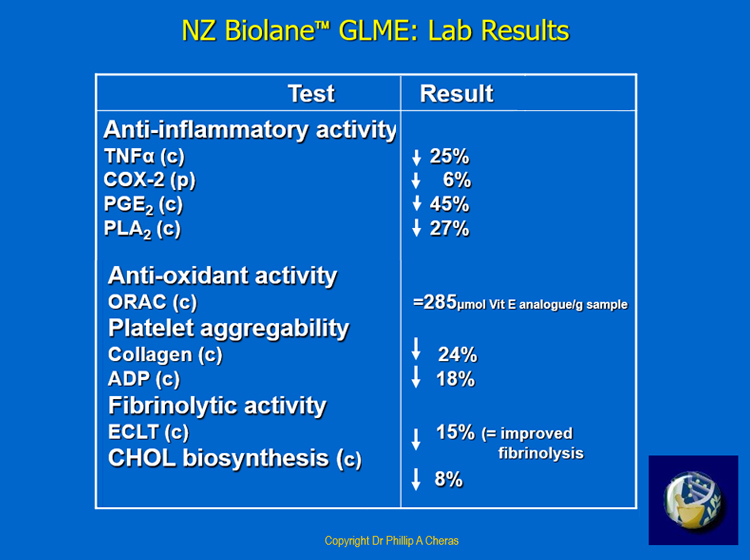
TNF- α was inhibited by 25%. COX-26%, you might say not very significant. The COX-2 inhibition. I want to explain a little later why it is very significant. Group-2 PGE 45% inhibited, no inhibition of group 3, PGE-3 is not inhibited, PLA2 27% inhibited all moderate levels of inhibition. That is not a big anti-oxidant, in capacity but it is anti-oxidant. Platelet aggregation was down 24% so there’s no risk of thrombosis, no blood clotting. Fibrinolytics, reasonable, 15% that’s good. Cholesterol inhibition, this is not an ant-cholesterol product however because it contains long chain marine fatty acid, it had an 8% inhibition of cholesterol biosynthesis.
4) Dose related inhibition of TNF- α
Studies conducted in the United States have shown that GLME dose-dependently inhibits IL-1 and TNF-α.
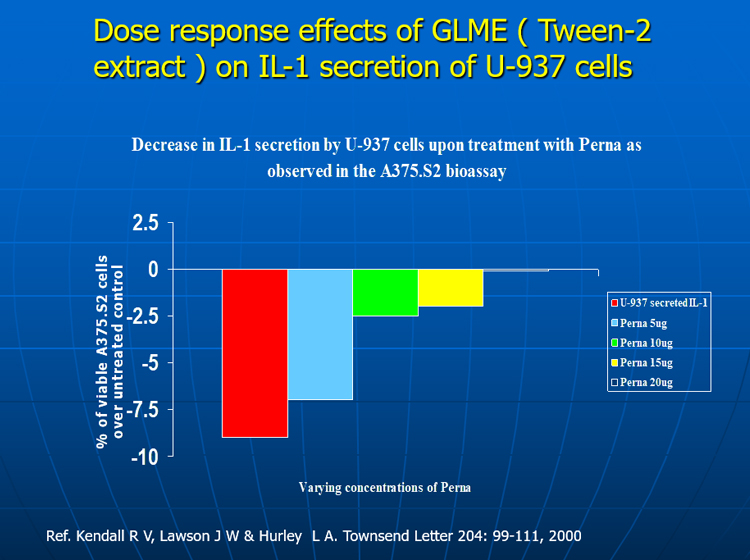
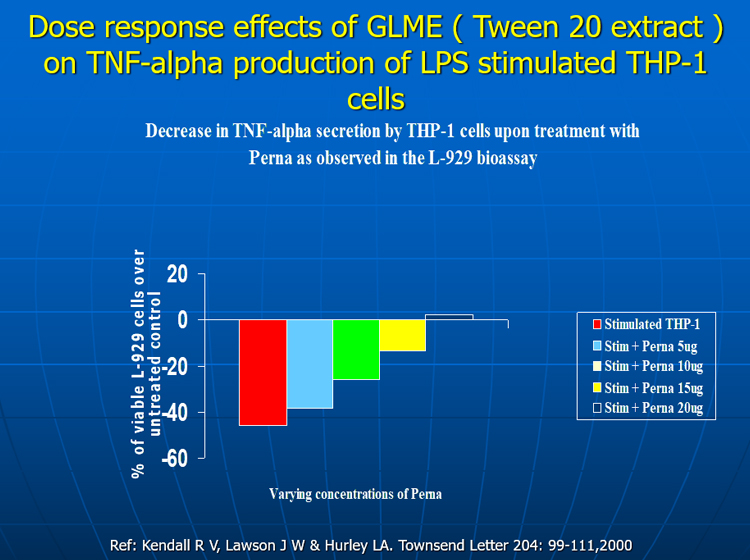
5) Effect of GLME on edema
Below is the rat footpad after injection with carrageenan. Carrageenan is seaweed and it also has health benefits. But in this particular method of use, it is used as highly inflammatory compound coming from the ocean. Then after the rat pore has been treated with the anti-inflammatory agent, GLME, here is the effect. Very good visual demonstration of anti-oedemic activity.
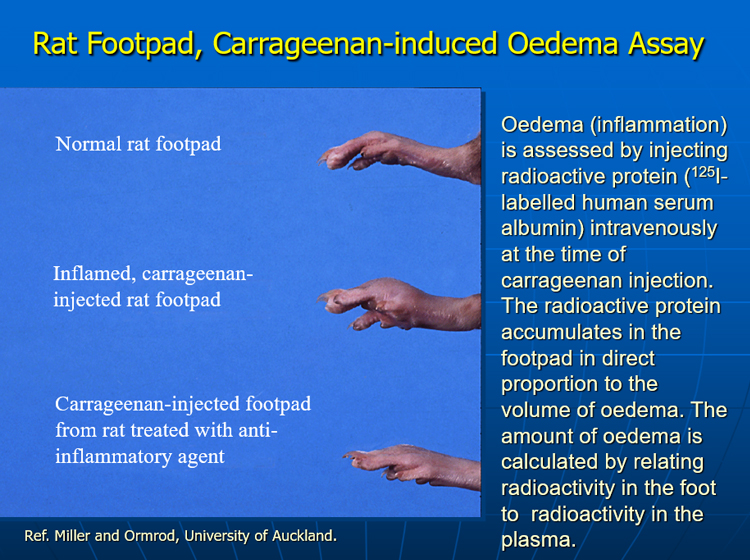
6) Clinical trials of Osteoarthritis Patients Taking GLME
There have been clinical trials on humans, and clinical trials double blind on animals. Particularly dogs and horses.
This is just one slide from a trial done in the United States. This was not double blinded trial. Because its not really very ethical some times to do double blind trials on people with osteo arthritis of the knee. Its not fare to the people who are on placebo. When its a long term trial. This trial was 6 months and about 105 people, and these are the clinical assessment, these are not patient assessment. These are clinically determined assessments and you can see that the green was excellent, 60% of the patients.
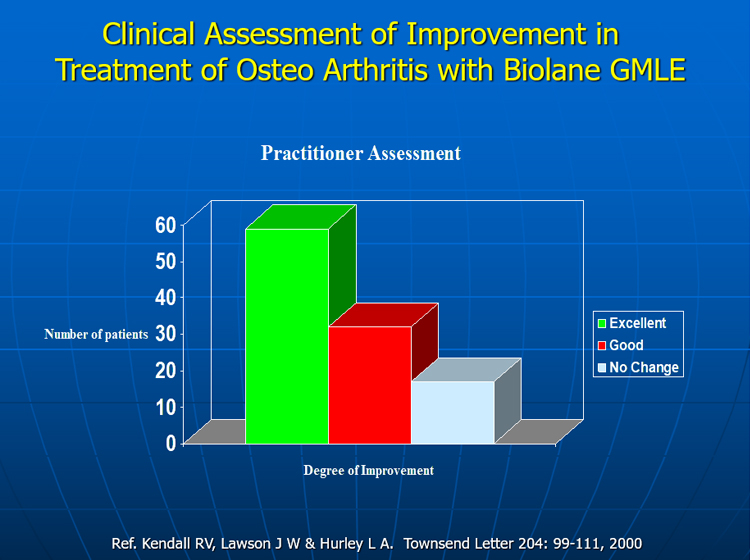
3. Effect of GLME on pain
One of inhibitors QOL, of course, is pain. If you don’t have any pain, quite often you don’t know you have the diseases. There are various of pain. We are mainly talking about somatic pain which is the one in bone, tendons, blood vessels, nerves ect. Psychological pain is so important also. I believe that depression can egsassivate, make worse, a disease state. And a very good happy attitude, positive attitude can help to recover from a disease state in addition to medication.
Pain of course is very significant in both arthritis and in cancer and it can result from various factors, blocked blood vessels, inflammation, tumor pressing on a nerve. But basically it’s caused by the pain sensitising prostaglandins, histamine and bradykinin being formed. This is a very basic expression of pain coming from a tissue injury releasing prostaglandins, histamine and bradykinin causing vasodilation, permeability and inflammation and then pain. Again we need if we can to inhibit, these factors. GLME inhibit this one, and it inhibit this one. Maybe that one, I don’t know but we do know about these two.
GLME Inhibits Prostaglandin and Leukotriene Synthesis
I mentioned before that I wanted to talk about that low level COX-2 inhibition. I think everybody now must be familiar and the next slide will show more with the controversy about COX-1, specific things like vioxin, syloxicare and things like that. But how ever, if you treat these things in balance then there’s a benefit to be obtain for the function that addresses both. So GLME does not inhibit COX-1 significantly, it does not inhibit COX-2 significantly. And it does inhibit the 5-lipoxygenase pathway. But they are at moderate levels for COX-2, nothing for COX-1, really, and a good moderate level for 5-lipoxygenase. I want to show you the significance.
Speaking generally, we regard COX-1 as being desirable prostaglandin synthesis. Because it provides constitutional enzymes that we need. However COX-1 also produces thromboxanes, TBX-2. COX-2 is regarded as not being desirable. COX-1 is normal. COX-2 is an induced situation when we have a disease states. It produces pro-inflammatory prostaglandin, but COX-2 also produces prostacyclins. This is where you can’t say very thing is bad or very thing is good you have to take a balanced look. And the prostacyclins, mediate the fromboxceins produces by the COX-1 cycle. So if you completely eliminate COX-2, you have no prostacyclins left. And those prostacyclins will not mediate, since theyre not there, the thromboxanes. This is why people who were taking vyocks were dying, because they were dying of Thromboses.
This is a very important factor. It emphasises again, my personal theory that moderate level treatments, long term is better than highly potent sudden treatments. As long as we were not dealing with acute cases. With acute cases sometimes this is different.
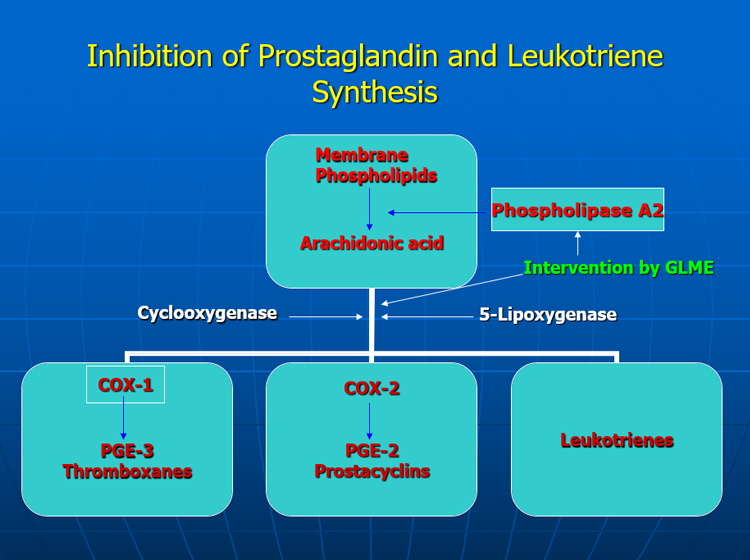
This is a very simply schematic situation of course membrane phospholipids are, you get phospholipipizy-2 breaking them down to arachidonic acid and then the three cycles, COX-1, COX-2 and leukotrienes from the 5-lipoxygenase pathway. GLME intervenes here is at phospholipipizy-2, but as you saw only moderately. It intervenes here, in the COX-2. It doesn’t actually inhibit COX-1 at all. But it also inhibits here.
Interestingly, GLME is not for treating asthma broncal disorders. But leukotriene cycle LTB4 is bronco constrictor and by coincidence GLME inhibits the production of LTB4. So, sometimes people with asthma will say that their asthma improved when they were taking GLME. But it is not treatment for asthma.
4. The Reactive Oxygen Cascade Effect
1) The Reactive Oxygen Cascade
Reactive oxygen (ROS) is a generic term for activated and highly reactive oxygen-related substances. Free radicals (atoms or molecules with unpaired electrons) are also a type of active oxygen. Peroxynitrite (ONOO-) is one of the most harmful ROS, others include hydroxy ions (OH-), hydrogen peroxide (H2O2), and nitric oxide (NO). ROS are generated by phagocytes, neutrophils, and cytokines such as TNF-α and IL-1β. They attack fatty acids which is cell wall, impairing cell membrane function and exacerbating the inflammatory process. The figure below summarizes the various effects of ROS.
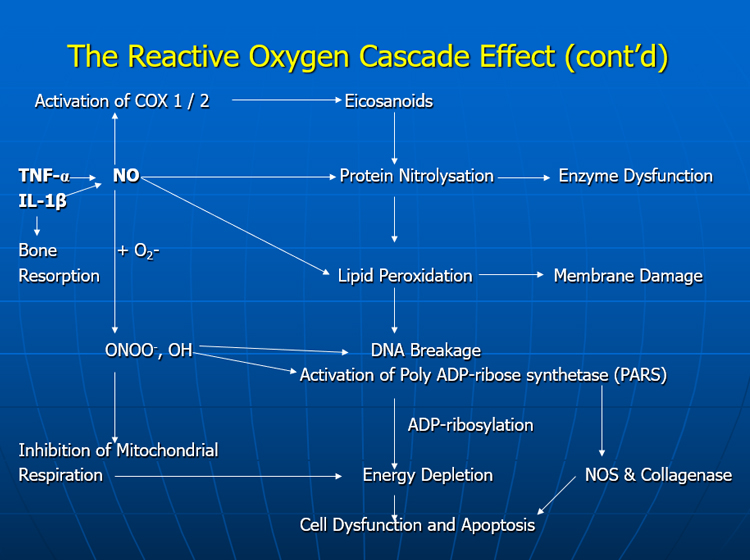
2) Effect of GLME on inhibiting ROC
Every batch of GLME that is produced is tested. To make sure that during the production process the activity that this extract has not been lost. The time and temperature functions involved in making this extract which is not a solvent extract. It’s made by physical centrofugual means and time temperature controlled.
One of the best inhibitors of ROS is Aspirin, Acetylsalicylic acid, and here Aspirin is used as the standard for each monthly test. The average level of inhibition of reactive oxygen by GLME for the whole year of 2005 which means 12 assays, shows 80% of the inhibition of Aspirin. Aspirin is a great inhibitor of reactive oxygen species.
Unregulated Cytokine Activity
Unregulated cytokines activity is responsible for so many of these degenerative conditions. Quite often they are the same cytokines that we want to inhibit for inflammatory disorders and stimulate for anti-cancer disorders and so we need to try and balance these things. For example, TGF-β is an anti-inflammatory growth factor but it is a pro-angiogenic growth factor and so the mediating activity of this simply extract from the sea, GLME is able to mediated these functions at an appropriate level.
Here is a seesaw. I think this is the most important slide in my whole presentation. Because it shows here we have IL-1, TNF-α. Of course there are others but these 2 in particular which we saw were undesirable because they are pro-inflammatory. If we inhibit these, this is good and bring the seesaw up and also we increase those we push that one down. But if we do this too hard, too strongly and we push down this side.
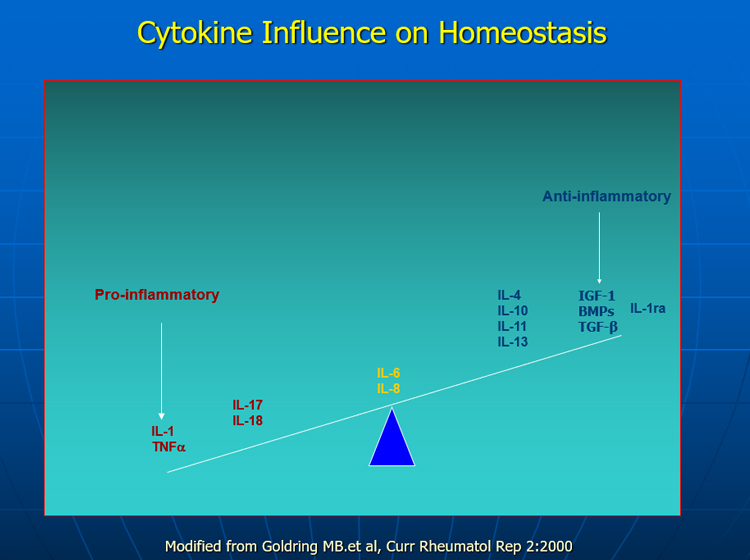
The ocean is the most balanced medium that we have on our planet earth. So many things that come from the ocean are so easily assimilated by the human body. Because the salt content, the saline content of the sea is very similar the sealine content in our bodies. But also its a balancer. In fact we wouldn’t be here if there was no ocean. It balances so many things that we need for life. Balancing the effect of these is very important and it’s when they are out of balance that disease states exist but at the risk of repeating they need to be done at a moderate level. This is where the value of natural substances that nature provides comes in to play by having only a moderate or low level multifunctional substance, you can address so many of these factors steadily and quietly. This is what these two products do, the marine lipids the Green Lipped Muscle Extract (GLME) and the Macolipin create anti-angiogeneic, anti-inflammatory activities. That actually will benefit chronic inflammatory situations, and although we do not work for tumor development or tumor growth they should apply in tumor development.
Conclusion
Complementary medicine using marine organism-derived products such as Macolipin and GLME, which improve cytokine balance, modulate angiogenesis and immune responses without causing the side effects of air travel, may be effective. The ocean is the most balanced environment on earth, and many great products are developed from it. Believe it or not, 80% of all life on Earth lives in the ocean. The sea still has great potential in the field of research and development of new health foods and therapeutic drugs.
